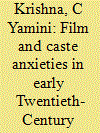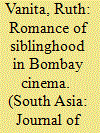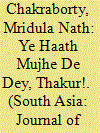|
|
|
Sort Order |
|
|
|
Items / Page
|
|
|
|
|
|
|
| Srl | Item |
| 1 |
ID:
191061


|
|
|
|
|
| Summary/Abstract |
Film was one of the new technological inventions of the ‘long nineteenth century’ that often instilled a fear of loss of the existing way of life and of disturbing existing social structures. In India, this manifested in a variety of ways, such as through the censorship of films by the government, but also by social codes which created major barriers for many to work in the film industry. In this article, I discuss film and its negotiations with caste in the twentieth century through close reading of the Indian Cinematograph Committee Report, film magazines, advertisements, audience responses and the speeches of nationalist leaders. I argue that rather than democratising desire by producing the universally desirable object of the star body, popular films in India produced desire that conformed to existing caste structures. The paper contributes to debates about early cinema and caste beyond the question of representation.
|
|
|
|
|
|
|
|
|
|
|
|
|
|
|
|
| 2 |
ID:
120702


|
|
|
|
|
| Publication |
2013.
|
| Summary/Abstract |
Bombay cinema endows non-sexual relationships, such as friendship and siblinghood, with a passionate intensity that equals that of sexual relationships, thus resisting a complete takeover of the emotional realm by heterosexual coupledom. Choosing sibling, friend or community over a spouse need not be seen only as retrogressive self-sacrifice; it can also be seen as choosing stronger, longer-standing relationships over newer, more flimsy ones. Films such as Naam, Bombai ka Babu and Kabhi Khushi Kabhie Gham explore the joys and costs of different types of romantic feeling, many of which are not sexual, but are just as powerful.
|
|
|
|
|
|
|
|
|
|
|
|
|
|
|
|
| 3 |
ID:
137263


|
|
|
|
|
| Summary/Abstract |
This essay argues that the figure of the dacoit/daku in Bombay cinema functions as the subaltern who is interpellated by, and yet cannot be contained by, the strictures of ‘modern’ law in a newly-independent post-colonial state. Reminiscent of an older polity, where rural outlaw figures operated as rebels to the existing social order inflected by caste and gender, dacoits in popular Hindi films give voice to the peasant insurgent, dispossessed of his land by age-old caste-based, as well as new, forms of governance. Taking up three screen dacoit characters in Bombay cinema, Gabbar Singh from Sholay (1975), Phoolan Devi from Bandit Queen (1994) and Paan Singh Tomar from Paan Singh Tomar (2010), this paper argues that in its obsession with the representation of dakus, Bombay cinema betrays its anxiety about a post-colonial juridical order that continues with the oppressions of feudal and colonial hierarchies. Thus, Bombay cinema continues to rely on the subaltern as idea and concept in order to map the tension between a nationalist/statist history and a narrative of rebellion and resistance from below, particularly in caste terms. (The term ‘Ye haath mujhe de dey, Thakur!’, from Sholay, translates as ‘Give me these hands, Thakur!’).
|
|
|
|
|
|
|
|
|
|
|
|
|
|
|
|
|
|
|
|
|